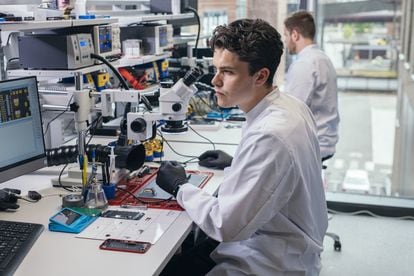A bad experience buying a second-hand mobile phone online was an eye-opener for Sami Marttinen. Seven years ago, the young entrepreneur bought a refurbished iPhone 6 Plus that he never received. After realizing that he wasn’t the only victim of this type of fraud, he began to research the phone market. He soon learned that 83% of the carbon footprint generated by smartphones comes from manufacturing and distribution, as confirmed by a recent Deloitte study. Marttinen asked himself, “Why does only 5% of the world choose to buy a refurbished device?” To attract more consumers to the refurbished device market, Marttinen and his partner, Jiri Heinonen, founded Swappie in 2016 to buy used iPhones to refurbish and sell.
When Swappie first started out, second-hand smartphones accounted for 5% of the European market. This market share has now tripled, according to the Global Refurbished Smartphone Market Report. “The evolution of the refurbished phone market is similar to the evolution of the used car market. In the 1990s, second-hand vehicles accounted for 10% of total sales, but now they command half of the market. Let’s hope the same thing happens with mobile phones,” said Marttinen.
Sales for the Helsinki-based company mirror the strong growth in second-hand mobile phones over the past five years. Swappie’s revenue grew from US$500,000 in 2017 to US$97 million in 2020. Marttinen funded the startup with 10 years of personal savings, and in 2020, landed US$150 million in venture capital from Verdane, Lifeline Ventures, and other environmentally sensitive investors.
The two Swappie founders observed that new smartphone prices kept climbing, yet the incremental innovation of the latest model wasn’t as significant as it was 10 years ago. “Device upgrade cycles are longer now. Consumers don’t change their phones every year, and are more open to buying older models to save money,” said Marttinen. According to consulting firm Kantar, in March 2021, consumers in Spain, Italy, Great Britain, Germany, and France kept the same device almost three months longer compared to March 2019.
The environmental impact of consumer products is an increasingly important factor influencing purchasing decisions, especially for younger consumers. More and more millennials are leaning towards refurbished devices as a more sustainable product. However, only 25% of consumers sell their old phones for recycling, showing that there is still a long way to go for consumers to develop confidence in the second-hand market.
Sustainable consumption
Swappie currently operates in 15 countries – Finland, Sweden, and Italy are its biggest markets. The Nordic countries have internalized recycling to a greater extent than the southern European countries, where many are still reluctant to buy second-hand products, says Fanny Niman, executive director of Swappie Spain. According to the firm’s latest survey, 70% of Spanish consumers would consider buying a refurbished device, but only a third prefer buying a refurbished device. “This is a considerable gap. Many users don’t know that second-hand devices are fully tested and come with a warranty in case of technical failure (Swappie provides a two-year warranty). The first step is to improve our branding and messaging, and Italy was an excellent test in this regard,” he said.
The Finnish company has its operations center in Helsinki, where 400 technicians inspect hundreds of mobile phones that arrive every day. After wiping all the stored data, technicians check the battery, camera, and speakers. If the phone is in perfect condition, it’s ready for sale. If not, it goes over to the repair department.
Robert Evans, a micro-soldering expert who has been with Swappie for two years, says that battery replacement is the most common fix needed to give a phone a second life. His workbench is littered with different types of glue, tiny computer chips, and tweezers of various sizes. “It’s like surgery and requires a lot of concentration,” said Evans. “Each phone takes 30-60 minutes, depending on its condition and the skill of the technician.” The repairs usually take less than a day to complete – a phone comes into the operations center in the morning, and is ready by the end of the day.

When it comes to the price of a used device, it’s all about aesthetics. Swappie has an evaluation department that assesses screen defects and assigns a score between A (excellent) and D (satisfactory) that reflects the phone’s condition. The price of a Swappie-refurbished iPhone can range between US$150-$1,000, depending on its condition and model. Otso Ojanen, Swappie’s director of operations and logistics, says that it’s often difficult to figure out which phones are most in demand. “If Apple is mostly selling the iPhone 13 these days, our iPhones 7 and 8 sell well because they’re cheaper,” said Ojanen.
Why has Swappie focused only on iPhones? Ojanen knows that Apple isn’t the only mobile phone manufacturer, but believes that focusing on a single brand was the key to streamlining operations and achieving success. “Android is an operating system used by many device manufacturers, so refurbishing all these different phones would be much more complex. We would need thousands of parts, and people who are able to repair many different models,” he said. Marttinen adds that the Apple still commands a large market share because consumers love the simplicity of its design and functionality.
However, the price of an iPhone is still a barrier for many people. “That’s where Swappie comes in,” said Marttinen. “Although our mobiles aren’t the latest generation, they’re cheaper and more environmentally friendly.” However, in some countries like Spain, Android’s popularity is overwhelming: 83% of all devices use this operating system, according to Kantar. The success of the Google-owned operating system may be an obstacle for Swappie when it comes to attracting new customers.
Swappie has not closed the door on expanding into other product categories. “In five or 10 years, I don’t see why there wouldn’t be a second-hand market for other devices. But iPhones still have great potential, and we have a long way to go – this is just the beginning,” said Marttinen.